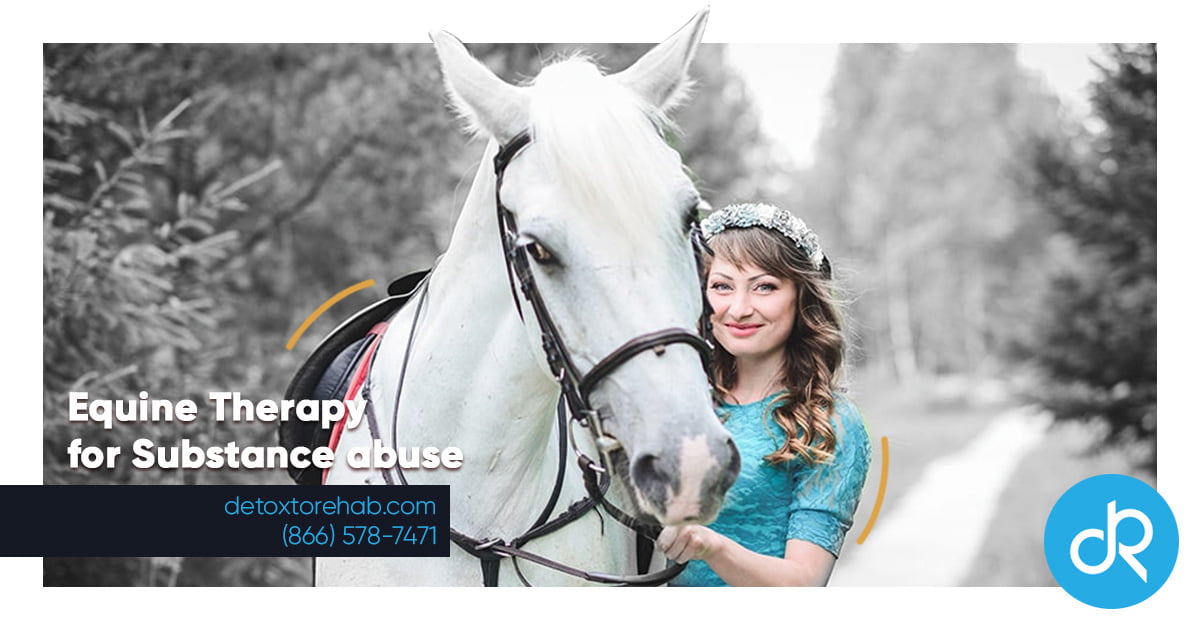

What is Equine Therapy?
An Animal-Assisted Therapy is a holistic approach to therapy that involves interaction with an animal, such as a cat, dog, or horse, in order to overcome addiction, psychological, and/or emotional issues that has become detrimental to their way of life. One form of this type of therapy is called equine therapy, aka equine-assisted psychotherapy (EAP).
Equine therapy involves the person suffering from addiction to regularly interact with horses over the duration of their rehabilitation. This helps promote emotional growth and personal development while there are undergoing treatment. This type of therapy has been effective in a variety of treatment scenarios for adults and adolescences.
Individuals who participate in equine therapy while recovering from substance abuse addiction often experience several life changing benefits and successfully complete their treatment plan.
Benefits of Equine Therapy
A study document in 2008 recorded the effects of a 12 week program of equine therapy on those who were suffering from anxiety, personality disorders, schizophrenia, and affective disorders. This case study found a higher levels of self-esteem and coping ability for those who took place in the program.
The use of both horses and other farm animals indicated that Animal-Assisted Therapy, especially the interaction with horses, made a significantly improvement on a person’s self-esteem and ability to deal with difficult situations.
Since substance addiction is classified as a mental health disorder, the use of equine therapy could also promote the same improvement in self-esteem and stress.
Equine therapy has been known to provide the following benefits:
- Non-verbal feedback: Horses are able to sense a person’s feelings and respond to appropriate situations. Their presence and animal affection offers the recovering addict attention that is nonjudgmental and free from prejudice.
- Learning opportunities: The recovering addict can use their interaction with the horse to evaluate and modify the ways they interact with people. The therapist can also use the horse as a method to open conversation about the person’s addiction and any other psychological or social issues related to their addiction.
- Trust-building: Those who feel uncomfortable talking in a traditional therapy setting might find equine therapy to be a safe environment where they can open up and develop trust.
- Healthy relationships: A non-judgmental bond can occur between the horse and the person. Those who struggle with anti-social consequences from their addiction begin to reestablish their confidence without criticism.
- Peace of mind: When an addict is in rehabilitation they tend to have a lot of time between meeting and group therapy. The down time can be a disadvantage as intense cravings, loathsome thought patterns, and negative reminiscing of their mistakes can cause relapse. The interaction with the horse keeps them out of their head and continues the therapeutic process with the horse.
History of Equine Therapy
Equine therapy is a method based on psychotherapeutic programs that includes a horse as part of the therapeutic team. Documented case studies imply that human to animal interaction has improved the quality of life. With an increasing use of animal-assisted therapeutic programs this method of rehabilitation has been proven to be extremely effective.
The first case studies focused upon the benefits of riding or vaulting. Therapeutic vaulting programs have been utilized for those with social anxiety and behavioral issues. Today’s programs adapted the principles of therapeutic vaulting by emphasize the developmental sequence of teamwork, compulsory moves, and communication.
Recently equine therapy techniques have focused this type of therapy at different groups of people like incarcerated law offenders, troubled teens, or people suffering from addiction or phobias. In-patient psychiatric and substance abuse programs have integrated these therapeutic techniques by teaching recovering addicts both verbal and non-verbal communication involved in the technique. Studies have shown significant improvement in 82% of trouble teens involved in Equine-Assisted Family Therapy.
How Does Equine Therapy Work?
Equine therapy programs differ depending on the rehabilitation center as they are often tailored to suit the unique needs of the addict and the severity of their addiction. The recovering addict will spend every day with a horse feeding, grooming, and bonding until they must attend a meeting. The other part of their day is dedicated to group therapy and individual therapy sessions, scheduled activities, and/or meetings. In equine therapy, the addict develops an emotional bond with the horse while tending to its basic needs. Surprisingly enough, equine therapy programs do not include riding as the horses are either too old for riding or have suffered injuries associated with riding accidents.

Therapeutic Techniques
- Pairing equine therapy with those treatment modalities.
- Daily routine of animal and human interaction.
- Teach recovering addict a new skill of animal husbandry.
- Introducing the horse as part of the therapeutic team to get the person to open up.
- Building healthy relationships and social interactions.
- Horses are calm and induce calming feelings in those who may be aggressive.

Conflicts with Treatment
- An environment suitable for horses.
- Allergic reactions to the horse’s environment.
- Funding that sustains the horse’s healthy lifestyle.
- Rehabilitation center must be certified in handling horses and responsible for the care and overall health of the animals.
References:
Neukrug, E. (2011). Counseling theory and practice. Australia: Brooks/Cole, Cengage Learning.
Frewin, K . & Gardiner, B. (2005). New age or old sage? A review of equine assisted psychotherapy. In The Australian Journal of Counselling Psychology, 6, pp13-17.








